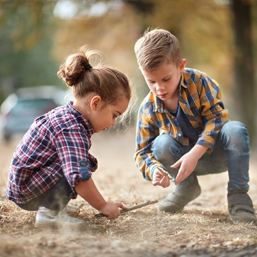
Loose parts play is an incredible way to spark imagination, promote problem solving, and empower children to take charge of their own play and environments. Loose parts are any materials that can be moved, carried, built and taken apart, lined up stacked together, and tinkered with.
Introducing loose parts play for the first time can be a little intimidating if you have no experience with it. This article will help guide you on how to bring loose parts play into your home, school or organization.
There have been reported barriers to implementing loose parts play, including from the parents, children and the environment. Some of the parental barriers can include fear of children getting hurt, misunderstanding the difference between risk and hazard, unsure of how to facilitate unstructured play, and fear of being judged by other parents for allowing their children to participate in activities viewed as ‘unsafe’. The children can be unsure of child-led, risky, unstructured play, be unaccustomed to outdoor play, or scheduled in so many structured activities that they don’t have time to engage in free play. Finding a safe place where children can play openly and freely outdoors can seem tricky, but all you really need is a small space and some creative play pieces.
If you are looking to do loose parts play in an outdoor space, try to find an environment with some diversity – trees, rocks, stumps, hills, sand – to increase opportunities for play without needing additional equipment. You can also set up loose part play indoors; make sure you have plenty of space to move around, and be mindful that the materials you use don’t damage the space.
When collecting materials for your loose parts play, consider what type of play you want to create. Some items are better used for construction play, like blocks, timber, PVC pipes and tools, and others are best suited for imaginary play like fabric and boxes. All the materials need to be light enough that they can be moved, carried, manipulated and tinkered with by children. Craft supplies, old tires (with help), large spools, natural materials, wood, foam, pots and pans, buckets, rope and tape all make terrific materials. You want to look at the type of materials and time of year as well – cardboard is fantastic but can be extremely slippery on snow, and some metals or black plastic can be hot to the touch in warm weather. Gathering materials can be as easy as going through your own garage or recycling bin or asking your friends and family. To gather more, you can connect with local recycling or junk clearing facilities, furniture making or automotive companies, fabric and craft stores or hardware stores.
Most of the synthetic materials used in loose parts play, like buckets, tires and PVC pipes, can be left outdoors with little chance of them being ruined by the elements. More soft materials like fabric and cardboard will need to be stored in an airtight container so they can’t become mildewed with exposed to water, humidity or snow. If you are running loose parts play at a school, are you able to have a potting shed outside, or do you have storage space inside? Other loose parts storage options include play boxes, plastic tote bins or more permanent storage options like sea cans. A good practice to get into is sorting through the play materials on a regular basis to make sure that there are no broken or sharp pieces, nothing is rotting from the weather, and the play box hasn’t become a dumping ground for materials not suited for play. You can also rotate out the materials to give more creativity and opportunity for play.
If you are unfamiliar with loose parts play, the best thing to do is to just get in and explore. Sort through the space, pick up pieces and put them down, start stacking or putting things together, start building and creating and see where your imagination takes you. If you are encouraging children to participate in loose parts, you can lead by example; start playing yourself and get the children to help. You can ask them questions like “what do you see?” “What would you like to build?” “What do you think you can create with those pieces?” Allow the children to lead the play and create what they desire; try to avoid telling a child what you think their creations are (i.e., “I like your pirate ship,”) and ask them what they have built. Encourage them to tell you how they came up with the idea, and what their next steps are going to be. Children are exceptionally creative by nature, and they excel in environments where they can control their play, and create to their heart's content. Use the above steps to set up the loose parts playscape and watch the magic happen!
Sarah has a Bachelor of Physical Education from the University of Alberta and was the supervisor for The City of Calgary’s Mobile Adventure Playground. As the owner of Playful Adventures (IG: @playfuladventures), she is passionate about bringing back unstructured, loose parts, outdoor play. Reach her at This email address is being protected from spambots. You need JavaScript enabled to view it.
Calgary’s Child Magazine © 2024 Calgary’s Child